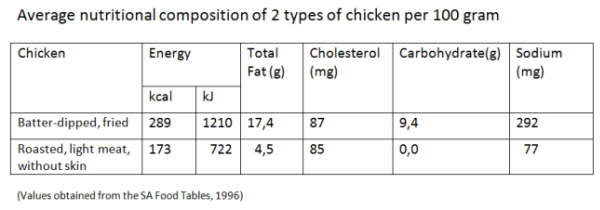
In view of the vast advertising campaign that will be launched in the Mother City on Heritage Day by Hungry Lion, I thought it may be relevant to compare the nutritional value of various ready-to-eat chicken dishes.
World Record attempt
Hungry Lion will attempt to break the Guinness World Record for the world’s largest serving of fried chicken by distributing 11,000 pieces weighing more than 1,1 tonnes (1,100 kg) of fried chicken to residents at the Liberty Mall in Mitchells Plain, Cape Town on the 24th of September this year. Each donated chicken portion will be accompanied by a donation of 330 ml of free Coca-Cola.
While the Hungry Lion company may well be in a bid to break the previous world record which is held by KFC when they served 907 kg of fried chicken four years ago in Kentucky to celebrate the 70th birthday of the Colonel’s empire, the South African event will probably also be a masterful advertising exercise.
Conflict of emotions
As a nutritionist I am also worried at the choice of items selected for this challenge. I would be happier if the participants were being given grilled chicken and a drink that does not contain sugar and flavourants. So to sort this problem out in my own mind, I had a look at the nutritional value of chicken prepared in different ways and the energy value of carbonated cold drinks.
Read: What exactly is in that chicken nugget?
It is important to keep in mind that the values listed below are not set in stone and that a great many factors can influence the nutritional value of foods. In relation to chicken dishes the following factors may play a role:
1. The cut or section of chicken
Different cuts or sections of the chicken can have quite different values, e.g. roasted chicken breast without the skin has a much lower energy value than dark meat roasted with skin, namely 722 kJ/100g versus 1059 kJ/100g respectively. In other words the presence or absence of the skin and the type of meat (light or dark) can increase the energy values dramatically (in this example by 337 kJ/100g or nearly 50%).
2. Deboned or not
The presence or absence of bone in a portion of chicken will also influence the energy and nutrient contents. Because of the bone, a drumstick will provide a smaller portion of meat than a chicken breast which is solid meat.
3. Food preparation methods
Methods of food preparation have a great influence, with grilling probably adding the least to the energy and fat content, whereas roasting or deep-frying and coating the chicken in crumbs or batter that absorb oil will boost the energy content (e.g. chicken breast grilled 617 kJ/100g versus chicken breast crumbed and deep-fried in oil 1210 kJ/100g. By crumbing and deep-frying the chicken breast, the energy content has practically been doubled)
4. Oil used
When it comes to fat content, then the type of oil or fat that is used to fry chicken can influence the nutritional composition of the fatty acids in the serving, but the total fat content is determined by factors such as cooking temperature and how much fat the batter or crumb coating absorbs.
The comparison
Because the Hungry Lion company has not yet posted the nutritional values of their dishes on the Internet, I had to use the values given in the SA Food Tables for batter-dipped, fried chicken as sold by “other chicken franchises” versus roasted chicken, light meat only, without skin, both expressed per 100g (comparing equal portions):

A 100g portion of chicken that is coated either with crumbs or a batter therefore has higher energy, total fat, carbohydrate and sodium contents than roasted light meat chicken without skin and without crumbs or batter.
A 100g portion of carbonated cola contains 167 kJ, so the 330 ml donated Coca-Cola will contribute another 501 kJ to the meal.
Anyone eating 100g of deep-fried chicken and drinking a 330 g can of cola drink will ingest a total energy content of about 1540 kJ or 24,4% of the suggested energy intake for an adult woman who is trying to lose weight or 18,3% of the suggested energy intake for sedentary adults. Neither of these contributions are excessive, but the meal is certainly not balanced and the fat content of the deep-fried chicken dish is high. In addition, the flavourants added to the coating or batter have a relatively high sodium content (about 10% of the recommended 3 g per day).
Read: Fast foods packed with sodium
Conclusion
While having take-away foods once in a while as a treat is acceptable in a balanced diet, getting hooked on foods and beverages that have the potential to increase our energy, fat and sodium intakes is not a good idea. So let’s hope that the Guinness World Record for the world’s largest serving of fried chicken does not result in South Africa earning another less welcome World Record as one of the heaviest nations on earth.
Read more:
Fried food boosts prostate cancer risk
Chicken meat may protect the heart
Is organic chicken worth the price?




 Publications
Publications
 Partners
Partners













